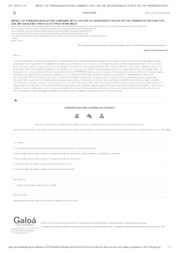Impact of thermovinification combined with the use of indigenous yeasts on the fermentation kinetics and metabolomic profile of syrah wine must.
Impact of thermovinification combined with the use of indigenous yeasts on the fermentation kinetics and metabolomic profile of syrah wine must.
Autoria: SILVA, I. S.; BARROS, A. P. A.; SILVA, G. A. da; AGUSTINI, B. C.; BIASOTO, A. C. T.
Resumo: The thermovinification technique, as a replacement for traditional maceration, is primarily applied to increase the extraction of phenolic compounds and may impact the yeast growth dynamics during alcoholic fermentation, affecting the quality of red wine. Concurrently, the use of indigenous yeasts is currently proposed as an alternative to promote greater aroma complexity and typicity of the wine. The objective of this study was to evaluate the combined effect of thermovinification and the use of indigenous yeasts on the fermentative kinetics and metabolomic profile of Syrah red wine must. The yeasts were isolated from Syrah grapes from the Sub-middle Sao Francisco Valley region, Brazil. The tested yeast strains were: commercial Saccharomyces cerevisiae MaurivinPDM®(PDM); indigenous Saccharomyces cerevisiae yeast(SC); and the combination of indigenous yeasts Hansenispora opuntiae and Saccharomyces cerevisiae(HO+SC). The wines were vinified using maceration during the fermentation for 7 days (traditional method) and thermovinification (65°C, 2h), totaling six treatments. Throughout fermentation, quantification of sugars, alcohols, and organic acids was performed using chromatography (HPLC/DAD/RID), as well as the cell viability analysis, biomass, soluble solids, pH, total acidity, and density. Thermovinification increased the cell viability of indigenous yeasts, promoted higher substrate consumption rates and product formation (ethanol), improving the productivity and yield of the fermentation process, and also increasing the levels of organic acids. The combination of the thermovinification technique with the use of isolated indigenous yeasts can be recommended for the production of Syrah red wine in the Sub-middle Sao Francisco Valley region as an alternative to strengthen the recently obtained Geographical Indication for the region. Future studies should investigate the impact of thermovinification technique and indigenous yeasts on the profile of other metabolites, such as phenolic and volatile compounds.
Ano de publicação: 2023
Tipo de publicação: Resumo em anais e proceedings
Unidade: Embrapa Uva e Vinho
Palavras-chave: Hanseniaspora opuntiae, Sub-middle Sao Francisco Valley, Tropical red wines, Vinho
Observações
1 - Por padrão são exibidas publicações dos últimos 20 anos. Para encontrar publicações mais antigas, configure o filtro ano de publicação, colocando o ano a partir do qual você deseja encontrar publicações. O filtro está na coluna da esquerda na busca acima.
2 - Para ler algumas publicações da Embrapa (apenas as que estão em formato ePub), é necessário ter, no celular ou computador, um desses softwares gratuitos. Sistemas Android: Google Play Livros; IOS: iBooks; Windows e Linux: software Calibre.
Acesse outras publicações
Acesse a Base de Dados da Pesquisa Agropecuária (BDPA) para consultar o acervo completo das bibliotecas da Embrapa.

